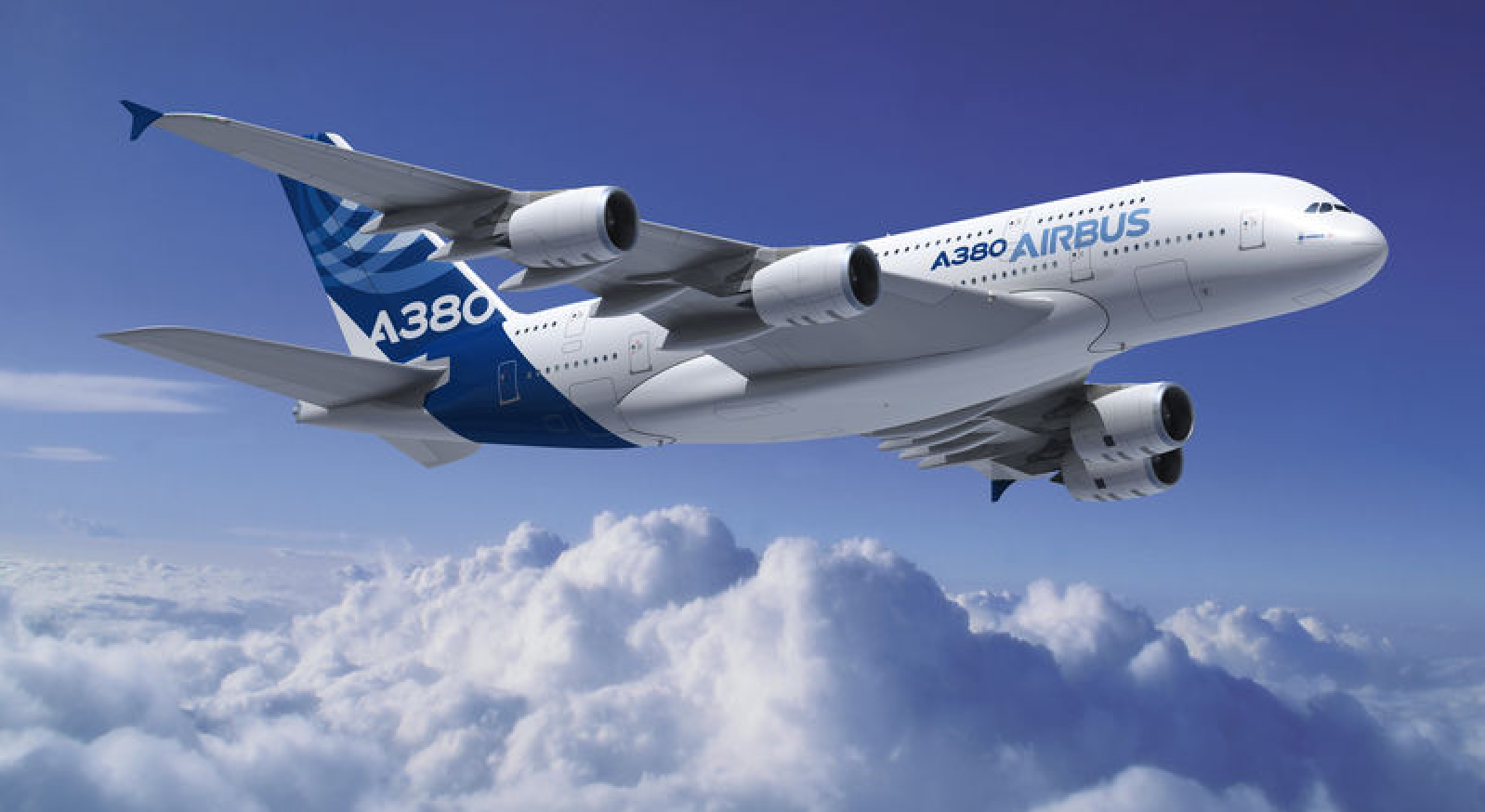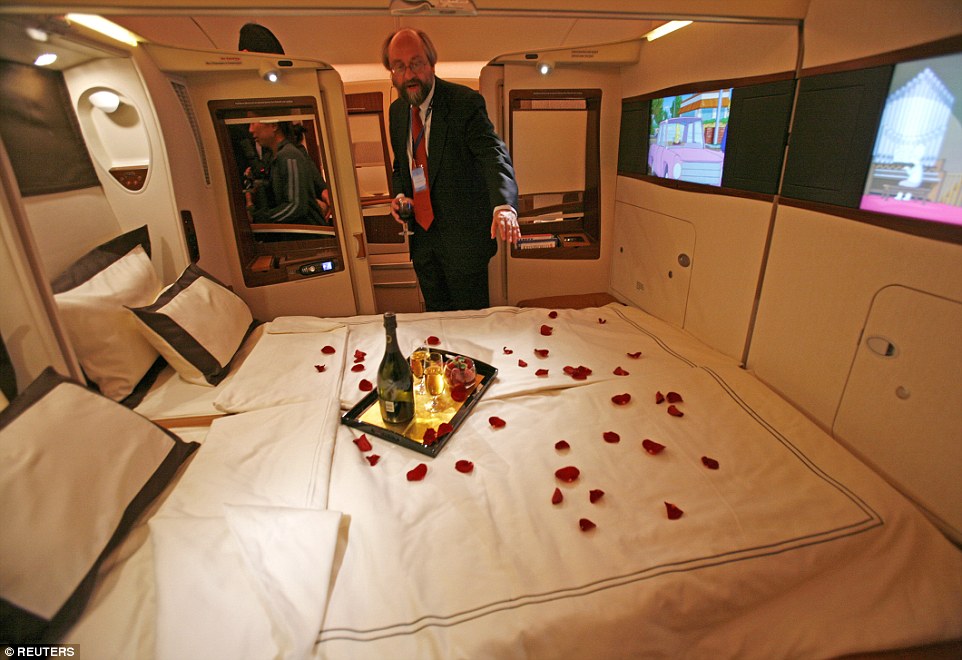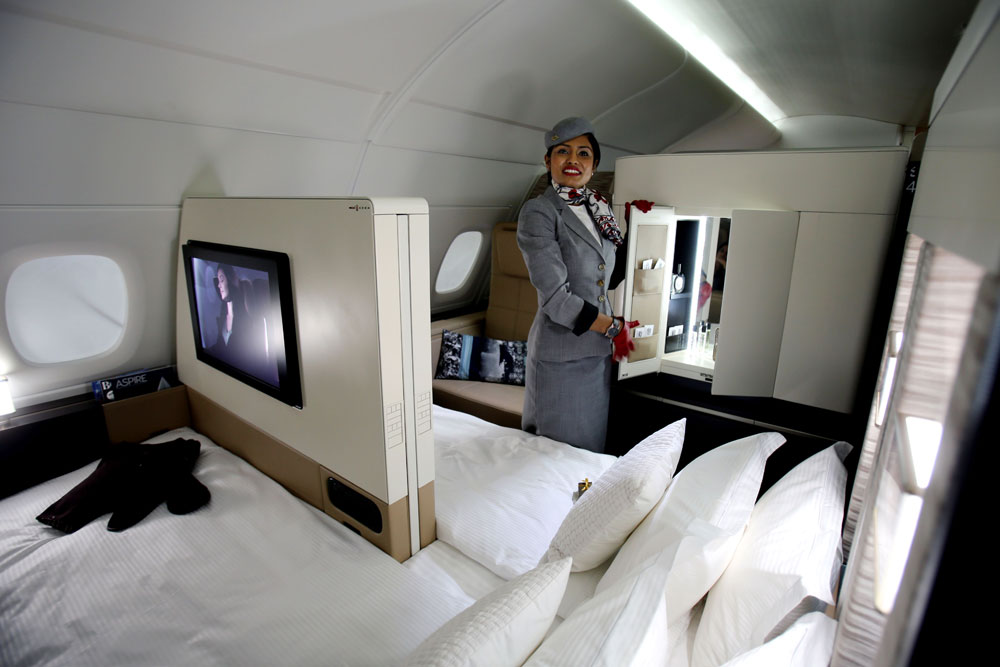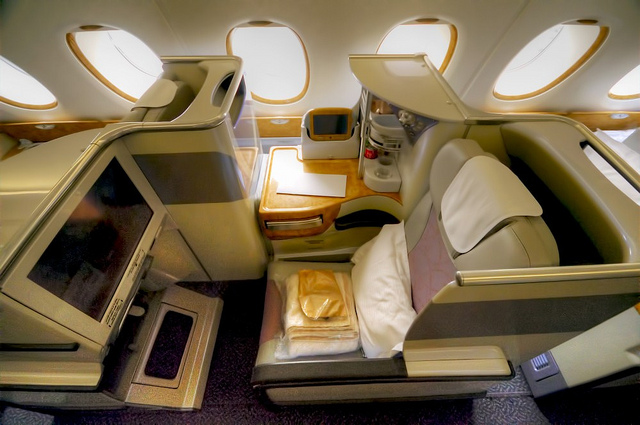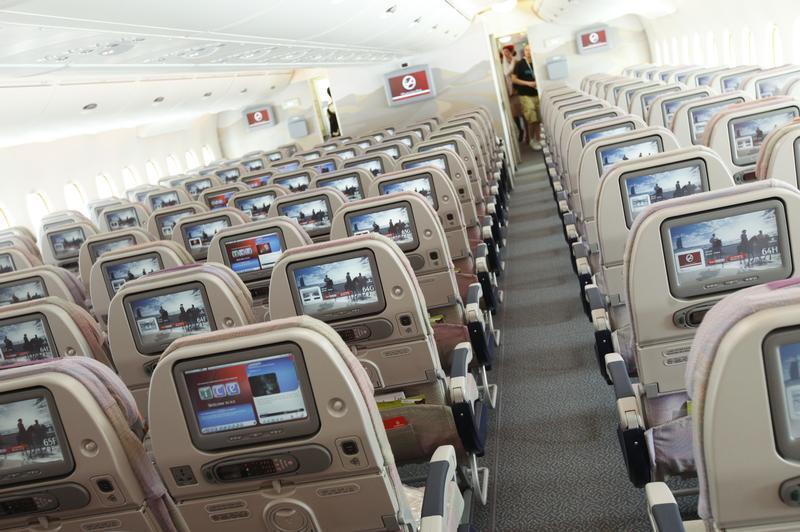The Airbus A380 is a jet airliner which has caught the imagination of travellers with its four engines, double-decking, and for being the world’s largest passenger aircraft totaling 6,000 square feet.
That is 50% more than the Boeing 747 and can travel to a cruising altitude of 39,000 feet in less than 15 minutes. Travelling in the A380 is quiet and feels more like being on a cruise ship than an aircraft.
Traveller fatigue and passenger comfort have been heavily considered with the design and the cabin has become 50% less noisy then other aircraft. This has been achieved by developing a more highly pressurization environment.
The windows are larger, the overhead storage is more, and the A380 has an extra 2 feet extra headroom compared to the 747-400. The seating configuration ranges from 4 across in first class to 11 across in economy.
The Airbus A380s length is 238 feet 7 inches, has a wingspan of 261 feet 8 inches, and has a massive height of 80 feet 3 inches. Its maximum design speed at cruise altitude reaches 634mph.
The upper and lower decking are connected by two stairwells at the front and back of the aircraft and are wide enough to allow two passengers to walk side-by-side. The total carrying capacity is 853, with a typical capacity of 533 passengers (a comfortable 3 class configuration), including 10 first class, 76 business class, and 439 economy class seats.
The aircraft is powered by Rolls-Royce Trent 900 or Engine Alliance GP7200 engines, and has a range of up to 8,200 miles, the distance from Dallas to Sydney.
Eco-Friendly
With the A380 being a cleaner, quieter, smarter, and greener aircraft the aviation industry now has a new benchmark for environmental standards. It has lower fuel consumption than other planes and has reduced CO2 emissions.
Who’s Flying the A380?
The A380 operates with the following airlines, offering short, medium, and long-haul services:
- Singapore Airlines
- Emirates
- Qantas
- Air France
- Lufthansa
- Korean Air
- China Southern Airlines
- Malaysia Airlines
- Thai Airways International (THAI)
- British Airways
- Asiana Airlines
- Qatar Airways
- Etihad Airways
Airbus A380 First Class
Singapore Airlines were the first carrier to create first class suites which were fitted out on the Airbus A380. They are exclusive and private and sit at the very pinnacle of first class travel, having their own showers and fully enclosed cabins.
Emirates then further developed the suite concept and stepped it up on their A380s with introducing a bathroom and in-flight showers to their first class voyagers.
They also introduced the first business and first class in-flight lounges where people could gather around a small bar which was richly supplied with expensive alcohol.
Etihad’s ‘The Residence’
This is the first of its kind and is at the very highest end of the market, towering over first class.
Etihad’s route from London Heathrow to Abu Dhabi has burst onto the European aerospace market with a new cabin class leader and something only once dreamed of back in the Concorde days.
The launch of the new ’Super jumbo’ Airbus A380 and the Boeing B787 Dreamliner are the craft that have been developed by this carrier to offer gloriously pampered air travel. Once you have ascended the stairway to the upper deck you are met with The Residence and the other nine suites, measuring 39 square feet of cabin space.
Enter Etihad’s new gold cushioned, private luxury penthouse in the sky called ‘The Residence’ and you will feel as though you are in an affluent hotel apartment which oozes high end indulgence.
Here you will find every possible comfort for the cash flush travel wary passenger, including your own shower spa, Poltrona Frau leather sofa which folds out to an 80 inch bed, and chic private bathroom.
The suites enjoy amenities such as massage functions, the flexibility of adjusting your seats firmness, a personal chilled minibar at your finger tips, and custom mood lighting. Storage is vast with its new lavishly spaced units and a large personal mirror which contains an array of toiletries, including La Lobo skincare products.
This is an indulgent ambitious piece of theatre, which pioneers a new generation of flight travel and will cost you around $20,000 for a one-way flight from London to Abu Dhabi.
Airbus A380 Business Class
In business class the cabins are private, have their own comfortable flat bed seats, and provide duvets, mattresses, and pillows. The suite is not totally enclosed as first class is, but the console acts as a privacy barrier, giving a more than acceptable level of privacy.
Window seats have thigh-level compartments for hand luggage and run along the side under the windows. There is also a personal minibar within reach stocked with chilled drinks and a shared lounge area with a bar that accommodates around a dozen people.
Airbus A380 Economy Class
Even in economy the double-decker A380 feels like a large hotel. The seats are 18 inches wide with 32-34 inches of leg room. They are much more comfortable than you might expect and the inflight entertainment system is high tech, having a state-of-the-art In-Flight Entertainment System (IFE).
The main deck cabin of the A380 is the widest of all airlines giving travellers more space with the seating and aisles, and ultimately a more pleasant flying experience.
In-Flight Entertainment
Airbus was the pioneers for connectivity and in June 2007 was the first to get certification for its in-flight mobile phone system. Since 2010, Airbus operators have been able to offer broadband and mobile telephony.
A380s have impressively sized television screens and are designed to be fitted with the In-Flight Entertainment (IFE) system.
This offers passengers personal screens with on-demand video and audio, giving access to hundreds of movies and audio programs including satellite TV broadcasts, news, flight information in their chosen language, and live views of the outside via landscape cameras.
Additional legroom is achieved by integrating the latest IFE platforms into the seats – doing away with the need to fit them into bulky under-seat control boxes.
Combined data and power cables allow passengers to connect their own electronic devices to their screen, and recharge their smartphones/tablets/laptops via a convenient USB attachment.

 En
En Es
Es Fr
Fr